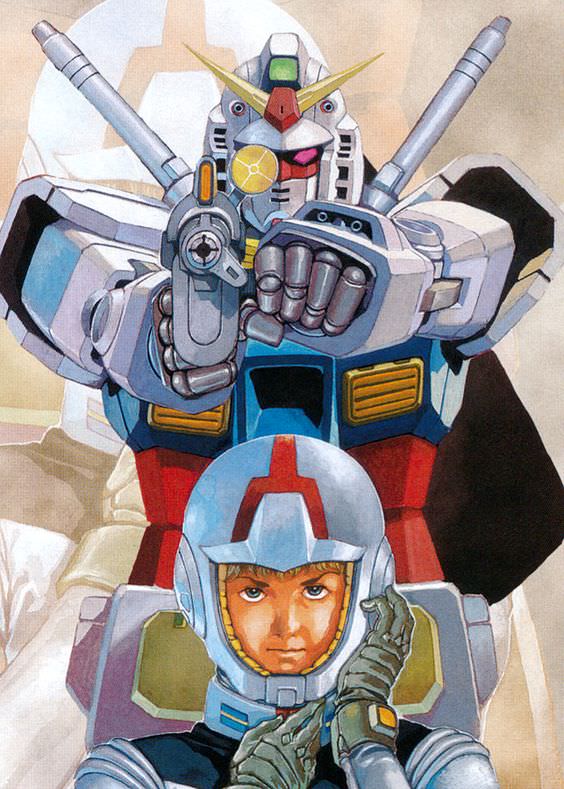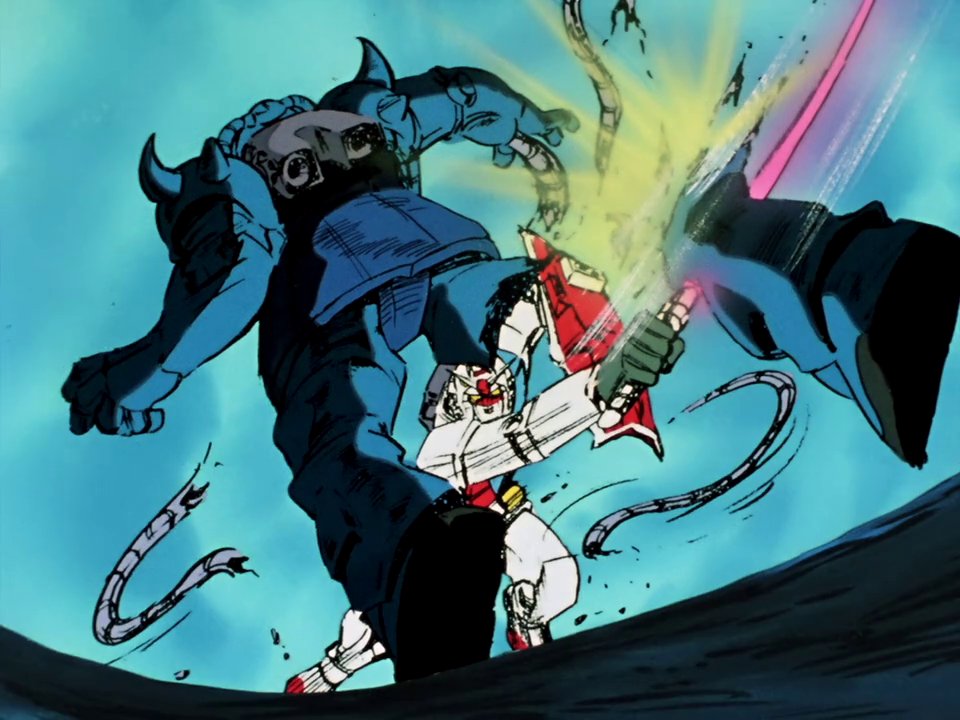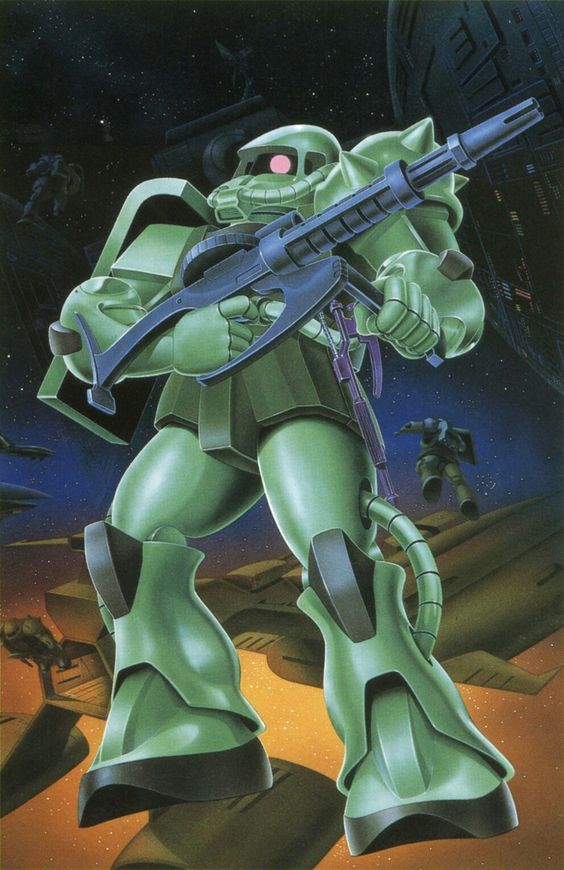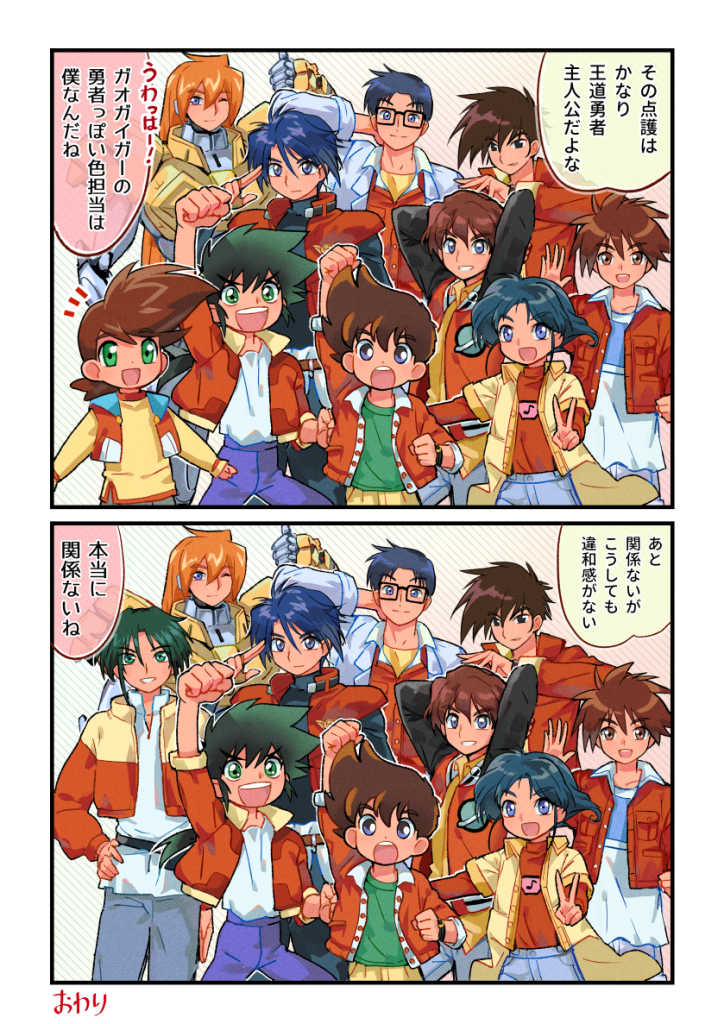
Mobile Suit Gundam is a long running mecha franchise that created the “Real Robot” genre. To give a brief explanation, the Real Robot genre typically has a more militaristic feel where logistics, geopolitics, and the fragility of human life in a conflict are often at the forefront. That’s not to say Super Robot shows cannot do the exact same (and have done so), but Real Robot shows generally embody those traits while trying to stay as grounded and realistic as they can within the boundaries of their setting.
Trying to shoehorn every single mecha anime into a strictly Super or Real Robot classification is generally an exercise in futility, but the broad strokes of Super Robot and Real Robot can be useful when describing a show to someone else.
Mobile Suit Gundam (1979) followed in the footsteps of Space Battleship Yamato (1974) by delivering a science fiction show with the main theme being “War is Hell”.
We’ll update this post periodically as we add more Gundam series to the MechaStellar game roster.
Mobile Suit Gundam – Universal Century (UC)
Table of Contents
- Mobile Suit Gundam Background
- The Order of Gundam’s Universal Century
- Summary of UC Gundam Starting Points
- Gundam Alternate Universe (AU)
Mobile Suit Gundam – Background

Mobile Suit Gundam was animated by Studio Sunrise and created by Yoshiyuki Tomino who was the overall director, script writer and visionary. Tomino previously had worked on Astroboy (Tetsuwan Atom), Space Battleship Yamato, Yuusha Raideen as Director for the first 26 episodes, Combattler V & Voltes V for storyboarding and directing, Zambot 3 & Daitarn 3 as creator and writer; for non-Mecha anime he had done a lot of work on Ashita no Joe.

Tomino is known for having an incredible and almost unbelievable creative output. For example:
Let’s look at Yoshiyuki Tomino’s commitments, 1977–88:
- Zambot 3 (23 eps), 8 Oct ’77 to 25 Mar ’78
- Daitarn 3 (40 eps), 3 Jun ’78 to 31 Mar ’79
- Gundam (43 eps), 7 Apr ’79 to 26 Jan ’80
- Ideon (39 eps), 8 May ’80 to 30 Jan ’81
- Gundam film I, 14 Mar ’81
- Gundam film II, 11 Jul ’81
- Xabungle (50 eps), 6 Feb ’82 to 29 Jan ’83
- Gundam film III, 13 Mar ’82
- Ideon: A Contact (film), 10 Jul ’82
- Ideon: Be Invoked (film), 10 Jul ’82
- Dunbine (49 eps), 5 Feb ’83 to 21 Jan ’84
- Xabungle Graffiti (film), 9 Jul ’83
- L-Gaim (52 eps), 4 Feb ’84 to 23 Feb ’85
- Zeta Gundam (50 eps) 2 Mar ’85 to 22 Feb ’86
- L-Gaim OVA (3 eps), 5 Nov ’86 to 28 Mar ’87
- Gundam ZZ (47 eps), 1 Mar ’86 to 31 Jan ’87
- Char’s Counterattack (film) 20 Feb ’88
That’s 393 original TV episodes, 5 compilation films, 2 original films, and 3 original OVA episodes; it’s something like 10,020 minutes of animation, at a rate of 18.5 minutes of animation for each week or 963 minutes of animation per year.
The blog 327 Robots provides the following sample.

Yasuhiro, Yoshikazu did the character designs for Mobile Suit Gundam and various other Gundam works, he would later create the Gundam The Origin manga decades later. While serving as animation director on many classic mecha shows he would later go on to direct Crusher Joe, Giant Gorg, Arion and Venus Wars.
The mecha designs were done by Kunio Okawara who had just previously worked on Zambot 3 and Daitarn 3. Although it should be noted that some of the initial mecha sketches were done by Tomino himself before being finalized by Okawara. Okawara is known for having a very distinct style and most of the Gundam portraits are seen as if you are you looking up from the feet of the mobile suit.
The mecha designs of both the Federation and Zeon would go on to make Okawara a legend in mecha anime. He’s done an incredible amount of work for Mobile Suit Gundam. You’ll see his beautiful artwork interspersed in this post.

Other notable staff include
- Yamazaki, Kazuo (Five Star Stories, Urusei Yatsura)
- Takao, Yotsuji (J9 Bryger, Baxingar, Sasuraigar)
And rockstar animators like
- Itano, Ichiro (Macross)
- Kazuo, Nakamura / Takigawa (Ashita no Joe, Mazinger, Getter Robo, Kotetsu Jeeg)
- Kanada, Yoshinori (Getter Robo, Yamato, Captain Harlock / Galaxy Express, Nausicaa, Princess Mononoke)
Sunrise previously handled subcontract work for bigger animation companies focusing on mechanical works, they started creating their own anime with the support of the toy sponsor Clover, their first work was Zambot 3, a very dark take on the mecha genre and was one of the shows that contributing to the “Kill em all Tomino” moniker.
The next show was Daitarn 3, a mecha comedy and an absolute favorite show among the MechaStellar staff. Neither show was a big success so their third and final chance at being a premier animation company was a show titled Mobile Suit Gundam.

The TV run of Mobile Suit Gundam was still sponsored by a toy company and so bears a lot of trappings of the super robot genre, including the Red/Blue/White/Yellow color scheme that sold well with kids, mid air combination sequences, various weapon accessories and machine combinations with the G-Falcon / G-Bull / G-Armor / G-Sky. The vast majority of these were removed in the Compilation movies.

Mobile Suit Gundam establishes a conflict between the Earth Federation and the Principality of Zeon, a group of space colonies who break away from Earth and launch a devastating first strike on the Earth Federation by dropping a space colony onto the Earth. Despite being a vastly smaller force they accomplished huge military gains by the use of a new technology, the Mobile Suit (MS), an 18m (60ft) tall robot that was highly mobile and could move like a human does.
MS revolutionized warfare by defeating warships and usurping the roles of traditional combat vehicles like aircraft and tanks. This was all possible due to the discovery of Minovsky particles that seriously degrade radar and other forms of electromagnetic waves and damage unshielded electronics making guided missiles and long distance targeting nearly impossible.

The story begins with Zeon’s Char Aznable, the principle antagonist discovering the Federations secret Mobile Suit project where it created the Guntank, the Guncannon and the eponymous Gundam in a supposedly neutral space colony. The surprise attack in the colony is thwarted when our protagonist, Amuro Ray, the son of the Federation’s mobile suit developer gets into the cockpit of the Gundam and fights them off.
The story then follows the crew of the White Base, who are civilian refugees conscripted into military service after the surprise attack, on their journey through space and across Earth hoping to deliver the mobile suit development data to the Federation headquarters in Jaburo all the while being chased by Zeon including many notable and sympathetic villains.
Gundam and other Tomino works are all remarkable for including huge casts of characters both for the protagonists and antagonists and does a good job of humanizing both sides of the conflict. While “War is Hell” there are ordinary people caught up on both sides of the conflict.

The TV series was not very popular and ended up getting cancelled and so the original ending was condensed and shortened to fit in their limited remaining episodes. Due to the popularity of Gundam model kits (Gunpla) especially those of the bad guy faction Zeon which was relatively unheard of for toymakers, Gundam received a surge in popularity which would later culminate in three compilation movies. Mobile Suit Gundam, Mobile Suit Gundam II: Soldiers of Sorrow, and Mobile Suit Gundam III: Encounters in Space.

These compilation movies feature beautiful updated animation, condensed stories, and iconic theme songs that older US fans may have heard a few hundred times playing Federation vs Zeon on your PS2. While the compilation movies are much shorter introduction to Mobile Suit Gundam the short run time also means you miss out on a lot of the slow building character development and world building of the TV series.
My personal recommendation is to watch the TV series followed by the compilation movies if you have the time.
If you want to read more about the production history of Mobile Suit Gundam please check out this page by Mark Simmons, the God Father of Gundam fandom in the US. https://ultimatemark.com/gundam/production/firstgundam.html
The Order of Gundam’s Universal Century
A general recommendation for getting into any franchise is to watch them in Production Order. This means watch the shows based on the based on the year they came out.
Here’s what production order looks like for the Universal Century of Mobile Suit Gundam.
- Mobile Suit Gundam (1974-TV)
- Mobile Suit Zeta Gundam (1985-TV)
- Mobile Suit ZZ Gundam (1986-TV)
- Char’s Counter Attack (1988-Movie)
- Gundam 0080: War in the Pocket (1989-OVA)
- Gundam F91 (1991-Movie)
- Gundam 0083: A Stardust Memory (1991-OVA)
- Victory Gundam (1993-TV)
- Gundam: The 08th MS Team (1996-OVA)
- Turn A Gundam (1999-TV) (Technically UC and AU)
- Gundam: Unicorn (2010-OVA)
- Gundam: Twilight Axis (2017-Short)
- Gundam: Hathaway’s Flash (2021-Movie)
If you’re not familiar, OVA stands for Original Video Animation, prior to the advent of streaming this was the primary market for doing home video sales in Japan rather than requiring a TV broadcast first and home sales later. OVAs (and movies) typically have higher production values for several reasons, one of prime reasons is they have a shorter runtime so they don’t have to spread the budget across a 26 episode or ~52 episode TV series.
Above is the production order for the Universal Century of Mobile Suit Gundam. Chronologically it would look like this:
- Mobile Suit Gundam (1974-TV)
- Gundam: The 08th MS Team (1996-OVA)
- Gundam 0080: War in the Pocket (1989-OVA)
- Gundam 0083: A Stardust Memory (1991-OVA)
- Mobile Suit Zeta Gundam (1985-TV)
- Mobile Suit ZZ Gundam (1986-TV)
- Char’s Counter Attack (1988-Movie)
- Gundam: Twilight Axis (2017-Short)
- Gundam: Unicorn (2010-OVA)
- Gundam: Hathaway’s Flash (2021-Movie)
- Gundam F91 (1991-Movie)
- Victory Gundam (1993-TV)
- Turn A Gundam (1999-TV) (Technically UC and AU)
While you could choose to watch the whole series in Chronological order, it doesn’t add too much. While 0083 takes place between Mobile Suit Gundam (0079) and Zeta Gundam (0087) it’s not essential viewing prior to Zeta Gundam in the slightest, it also have a very different tone and plot compared to MSG and Zeta Gundam so you would be better off watching those two back to back since you have the same writing, direction and animation style.
That said there are a lot of entries in the Universal Century of Mobile Suit Gundam. Some shows are sidestories and can be watched on their own without much prior knowledge of Gundam. Gundam 0080 War in the Pocket and the 08th MS Team both fill this role.
For an abbreviated entry into the Universal century you should watch Mobile Suit Gundam and Char’s Counterattack. For those who experienced Gundam with Toonami this is what happened in the US in the 2000s. All four movies are also currently available on US Netflix along with the CCA sequel Hathaway’s Flash.

While this skips over the Gryps Conflict and Neo Zeon war of Zeta Gundam and ZZ, they are not quintessential to understand Char’s Counterattack. If anything, Char’s Counterattack doesn’t fully adapt the story of Hi-Streamer so you might be wondering why Char’s motivations and ideals changed so much between Zeta Gundam and Char’s Counterattack. You’ll have to infer a lot from the ending of Zeta or read supplementary material regarding what has been translated about with Hi-Streamer.
Zeta Gundam is a personal favorite of this author, so I highly recommend watching it at some point if you decide to go the abbreviated route. It is best watched immediately after Mobile Suit Gundam (TV or Movies) so it’s still fresh in your mind.
Where to start Gundam’s Universal Century (UC)
Here’s a summary of the different options where to start in the Universal Century of Mobile Suit Gundam.
- Watch Gundam in production order
- Go this route if you love mecha anime and want to experience it from start to finish
- Watch a stand alone entry like 0080 War in the Pocket or the 08th MS Team
- Go this route if you only want to watch a single short series to see if you like the world and themes of Mobile Suit Gundam
- Watch an abbreviated order which is Mobile Suit Gundam Compilation Movies then Char’s Counterattack (CCA)
- Go this route to understand the main conflict of the One Year War as well as the biggest event in UC featured in CCA. If you want to watch Hathaway’s flash this is the shortest route to understand all the key background.

Where to start with a Mobile Suit Gundam Alternate Universe (AU)
Gundam is the biggest presence in the mecha genre, while the original work and many follow-on works all appear in the Universal Century (UC), it also had shows set in an Alternate Universe known as an (AU).
A Gundam AU is a standalone entry in an alternate universe that often bearing many tropes of the original Gundam series as well as references and homages either to specific characters or sequences. Most Gundam AUs will have a “Char Clone” and others might have a reference or a stand-in for another memorable character such as Ramba Ral and his Gouf or the Black Tri-Stars and their Doms.
Each Gundam AU is very different and often targeted at different demographics. For Sotsu-Sunrise and their new owner Bandai, who makes the Gunpla model kits and figures, the AU offers a way to develop entirely new stories using the major themes of Gundam and expand the brand to different audiences.
While UC is the cultural icon for Gundam as well as Bandai’s biggest revenue stream, the AUs are meant for casual viewers as an introduction to the main themes and story beats of Gundam without needing to know the long and storied history of Gundam. Any of the AUs can be watched standalone without seeing any other Gundam series, although you’ll appreciate the archetypes, references and easter eggs the more series you watch.
Below we’ll run through some of the different Gundam AUs and you can see if any of them appeal to you. We’ll update this post periodically as we add more Gundam series to the MechaStellar game roster.
Mobile Fighter G Gundam (1994) (TV)

The very first alternate universe Gundam, this was directed by Yasuhiro Imagawa who previously directed the incredibly high budget and well received Giant Robo: The Day the Earth Stood Still (1992-OVA) and bears a lot of similarities.
This Gundam show stars larger than life characters far in the future where all of humanities conflicts are settled by a global Gundam Fight where earth is the ring. In essence each country has a Gundam, themed after their country (Spain has a Bull, Norway has a Viking, Greece has Zeus, France has Napoleon etc.) and they fight in a championship to become the head of the Earth Goverment.
This series is notable for having an incredibly diverse array of Gundam designs, over the top action, and for taking Gundam in a drastically different direction. It is beloved by western fans but model kit sales did not do exceedingly well. It is also one of the few times where the English Dub is equal if not superior to the original voice acting and to this day still has many memorable and quoteable lines.
Go into this show expecting some wild action and great quotes and you’ll have a good time.
G Gundam has both a manga adaptation and a manga sequel but neither are translated in English as far as I am aware.
New Mobile Report Gundam Wing

This show features 5 nearly indestructible Gundams sent from the colony to each wage a one man war against the Earth Sphere Alliance and their Mobile Suit producers the Romefeller Foundation. This AU focuses on unrest between the colonies and Earth
While the mecha designs are great and the lopsided fights a lot of fun, the overarching story can be a bit droll and the true political motions opaque. If you go into this show expecting melodrama both good and bad you’ll enjoy it.
The series also has arguably the best Zechs clone out of any AU, but unfortunately his character development does a 180 as the show writers decide to replicate CCA’s plot for the final arc.
This was first Gundam show to air in the US and many fans still have a lot of nostalgia for it. It received a sequel OVA/Movie called Endless Waltz with updated designs by Katoki including the iconic Wing Zero with angel wings.
Go into this show expecting tons of melodrama and people shouting (often contradictory) political beliefs as mobile suits explode by the hundreds and you’ll have a good time.
It has received several manga adaptations include a side story called G-Unit The Last Outpost. The most recent manga adaptation is called Glory of the Losers (GotL) and condenses several parts of the TV show while providing some more background and motivations for the different characters and factions, it is definitely worth the read.
After War Gundam X

Gundam X is a UC what if story, where in the 7th space war the United Nations Earth (UNE) tried to stop multiple colony drops by the Space Revolutionary Army (SRA) using the Gundam X with it’s supporting G-Bits and their satellite cannons capable of destroying a colony. Unfortunately the SRA was successful and multiple colonies hit the Earth’s surface causing a long winter and creating a Mad Max-esque wasteland.
The story begins 15 years after war, where the protagonist Garrod commits grand theft auto on a mobile suit to rescue/kidnap the suspected Newtype girl Tiffa Adil. He later uncovers a surviving Gundam X and they learn the satellite system is still active.
This show aired immediately after Wing and was cut short like the original mobile suit Gundam. It suffered from ‘Gundam fatigue’ where year after year of Gundam shows wore out the audience. It has excellent character designs and a nice soundtrack. The Gundam’s are very similar to Gundam Wing while the average grunt Mobile Suits are a really nice rendition of classic One Year War MS from the original Gundam while still remaining distinct enough to stand on their own.

This is a favorite show of the author’s but it definitely has its share of problems. While the show starts off as a Mad Max-esque setting, the writers appear to either forget or just drop it entirely not too far into the show where the crew start pulling into cities that look perfectly normally and completely unaffected by Earth having multiple massive craters on it and the nuclear-winter that ravaged it for many years. The show is strongest in the beginning and ending arcs while the middle tends to meander and drag, especially after the Gundam Double X shows up.
One thing you’ll notice while watching the show is that the themes are relatively upbeat compared to most UC shows and many of the characters are rather positive considering the quasi-post-apocalyptic setting. Our hero, Garrod Ran looks and acts like he just stepped out of a Yuusha (Braves) show.

While the Captain and later his mentor is a combination of Amuro and Quattro. The supporting cast is great, with Tiffa Adill being an incredibly interesting take on Newtypes, and the slow budding and well-written romance between her and the protagonist is a breath of fresh air for most Gundam media.
Go into this show expecting an upbeat and positive take on a dystopian Universal Century with a good cast but meandering plot and you’ll have a good time.
Gundam X received a manga adaptation sidestory called “Under the Moonlight”. The Bluray release included a one-shot sequel with Garrod and Tiffa and was later included in the manga adapatation called After War Gundam X Re:Master Edition.
Turn A Gundam

Turn A Gundam is technically UC and also technically an AU. Turn A Gundam uses the mathematical symbol ∀ which means “For all” in other words Turn A Gundam is meant to be for all Gundam timelines and I’ll refrain from saying anymore without spoiling anything.
Turn A Gundam takes place in an Earth that appears to have people living with the technology (and fashion) of the early 1900s but all is it not what it seems. The series begins with the protagonist, Loran Cehack, descending to Earth from the Moon to to gather intelligence for the moon race.
As we quickly learn it appears as though the Moon Race is drastically more technologically advanced than the people of Earth, and one of the factions on the moon would like to return to the Earth although it may require military intervention to do so.
Disturbed by the giant robot the Earth militia attack with their byplanes and a sudden catastrophe strikes as the Big Zam-esque machine called the WaDom (walker dome) unleashes its antiship mega particle cannon.
Loran who had been taking part in a coming of age ceremony boards the Turn A Gundam which was encased in stone as legends state was the local guardian. It is called the White Doll instead of White Mobile Suit.

The most unique thing about Turn A Gundam is that the designs are done by Syd Mead who worked at Ford Motor Company for concept design and later did “Visual Futurist” work for Blade Runner and Aliens 2. You can read more about it on Moon’s Cocoon. The Turn A Gundam is often called the Mustache Gundam, even in its own show, and it is certainly the most distinct feature.
The story and pacing of Turn A Gundam is more of a idyllic slice of life interspersed with the horrors of war accompanied by a great soundtrack by Yoko Kanno. The main lead Loran does not do much to drive the plot, but he has great internal consistency where he always behaves as a loyal knight serving his Queen Dianna Soreil. Turn A also has an excellent supporting cast with many different motivations, plot direction and humor to say the least.
It’s a very Tomino production and you can tell that he and staff were overjoyed to be working on this project as a celebration of all things Gundam that came before it. In my personal opinion the ending sequence alone makes it a masterpiece.
Go into this show expecting a happy Tomino show with plot lines that alternate between idyllic slice of life and the callous loss of life in an uncessary war and you’ll have a good time.
While there is no particular order to watch Turn A Gundam, I think it’s best to watch it after having seen the major beats of the Universal Century. You’ll also appreciate the references more having seen G Gundam, Wing and X first. Do yourself a favor though, if you’re watching things in production order give yourself a break between the depressing Victory Gundam and the decidedly more whimsical Turn A Gundam.
Click here to return to the “Where to start mecha anime” landing page.